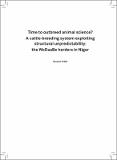| dc.contributor.author | Krätli, Saverio | |
| dc.date.accessioned | 2013-03-06T09:55:45Z | |
| dc.date.available | 2013-03-06T09:55:45Z | |
| dc.date.issued | 2008 | |
| dc.identifier.citation | Krätli, S. (2008) Time to outbreed animal science? A cattle-breeding system exploiting structural unpredictability: the WoDaaBe herders in Niger, STEPS Working Paper 7, Brighton: STEPS Centre | en_GB |
| dc.identifier.isbn | 9781858646995 | |
| dc.identifier.uri | https://opendocs.ids.ac.uk/opendocs/handle/20.500.12413/2439 | |
| dc.description.abstract | Cutting-edge research on agri-food systems contends that mainstream agricultural science is ill-equipped to address issues of complexity, diversity and uncertainty. The paper tackles this issue looking at animal breeding, an area of agricultural science that has so far remained marginal to the analysis concerned with dynamics and uncertainty. The focus is on systems operating with low external inputs and a structurally unpredictable environment. The paper builds on the author’s DPhil research on cattle breeding amongst the WoDaaBe herders in Niger.
The breeding/production system is geared towards exploiting unpredictable variability as a key resource (rather than contrasting or externalising it) and securing a reliable flow of production. Selection wise, the system makes use of both genetic and extra-genetic inheritable resources (extended inheritance). At the core of the system is the organisation of the cattle population in matrilineal lineages, as the main method for structuring animal diversity and ensuring the transmission of economically crucial functionality, both within the breeding population and across cattle generations. Examples of such functionality are competence as feeders (season-specific diet preferences in face of a great variety of grasses and browses, efficient heath management of negotiating of difficult terrain) and competence/specialisation for minimum-stress interaction with other herd members and with the herder (stable hierarchy, preferential relationships and social bonds, selective trust).
The paper argues that the breeding/production system run by the WoDaaBe (exploiting animal-human-environment interaction, using extended inheritance and geared towards high reliability) constitutes a form of enhanced production and land development only marginally represented by the current scientific model of animal breeding (environment-blind, focusing on genetics and geared towards streamline efficiency). | en_GB |
| dc.description.sponsorship | ESRC | en_GB |
| dc.language.iso | en | en_GB |
| dc.publisher | STEPS Centre | en_GB |
| dc.relation.ispartofseries | STEPS Working Paper;No. 7 | |
| dc.rights.uri | http://creativecommons.org/licenses/by-nc-nd/3.0/ | en_GB |
| dc.subject | Agriculture | en_GB |
| dc.subject | Science and Society | en_GB |
| dc.title | Time to outbreed animal science? A cattle-breeding system exploiting structural unpredictability: the WoDaaBe herders in Niger | en_GB |
| dc.type | Series paper (IDS) | en_GB |
| dc.identifier.externaluri | http://steps-centre.org/publication/time-to-outbreed-animal-science-a-cattle-breeding-system-exploiting-structural-unpredictability-the-wodaabe-herders-in-niger/ | en_GB |
| dc.identifier.koha | 184116 | |


